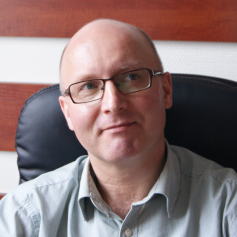Department of Anthropology is one of the most important and leading centres of research on human biology in Poland. Scientific staff deal with interdisciplinary research where three scientific disciplines overlap:

human biology (physical anthropology)

medical sciences (epidemiology)

social sciences (psychology, sociology and demography)
The main aim of research is an attempt to extend the present knowledge of directions of changes in biological condition of Polish population in relation to local and global changes of socio-biological environment. A characteristic feature of the Department is conducting regular, nationwide Surveys monitoring the state of the population: growth and development of children and youth, biological condition of Polish population, aging process, biological effects of social factors on differences in human biological condition (also in terms of historic populations) in a different stage of ontogenesis.
The current scientific interests of the Department are focused on three leading subjects:
- characteristic of biological well-being indicators of the contemporary and prehistoric Polish populations in different stages of ontogenesis;
- biological and demographic consequences of social stratification of Polish population and its secular changes depending on living conditions of different social groups;
- biological basis of human behaviour in perspective of evolutionary psychology and behavioural ecology.
Head of Department
Head of Department: Prof. Sławomir Kozieł, PhD, DSc, full professor (https://orcid.org/0000-0002-0584-4427)
 Since 2017, Slawomir Koziel is a professor and a head of the Department of Anthropology at the HIIET PASs. He received a PhD at the Wroclaw University in 1998, and a DSc (habilitation) in 2007. In 2016, he received a professorship, by nomination of the President of Poland. He is the author/co-author of more than 180 original publications, i.a. in the Lancet, Nature, Sports Medicine. He has promoted five PhD students and supervised 10 master theses. He was a principal investigator in 3 and a co-investigator in 7 national projects. He has also participated in 2 international projects, supported by British Council and EU. He took part in 18 short-term scholarships, i.a. 6 at the Oxford University (twice supported by the Royal Society). He is an international fellow of UBVO at the Oxford University (https://www.oxfordobesity.org/research-network), a chairperson of Auxological Society (Germany) and Editor-in-Chief of the Anthropological Review. He is also a member of 3 other international scientific organisations. His main interest are: human biology, growth and development of children, epidemiology of obesity, evolutionary ecology, biostatistics.
Since 2017, Slawomir Koziel is a professor and a head of the Department of Anthropology at the HIIET PASs. He received a PhD at the Wroclaw University in 1998, and a DSc (habilitation) in 2007. In 2016, he received a professorship, by nomination of the President of Poland. He is the author/co-author of more than 180 original publications, i.a. in the Lancet, Nature, Sports Medicine. He has promoted five PhD students and supervised 10 master theses. He was a principal investigator in 3 and a co-investigator in 7 national projects. He has also participated in 2 international projects, supported by British Council and EU. He took part in 18 short-term scholarships, i.a. 6 at the Oxford University (twice supported by the Royal Society). He is an international fellow of UBVO at the Oxford University (https://www.oxfordobesity.org/research-network), a chairperson of Auxological Society (Germany) and Editor-in-Chief of the Anthropological Review. He is also a member of 3 other international scientific organisations. His main interest are: human biology, growth and development of children, epidemiology of obesity, evolutionary ecology, biostatistics.
Team
Scientific Team:
- Dariusz Danel, PhD, DSc, associate professor (https://orcid.org/0000-0001-6175-3928)
- Agata Cieślik, PhD, assistant professor (https://orcid.org/0000-0003-3180-6974)
- Aleksandra Gomuła, PhD, assistant professor (https://orcid.org/0000-0003-2206-1659)
- Natalia Nowak-Szczepańska, PhD, assistant professor (https://orcid.org/0000-0003-2774-992X)
- Anna Spinek, PhD, assistant professor (https://orcid.org/0000-0003-0304-081X)
- Katarzyna Górka, PhD, assistant professor (https://orcid.org/0000-0001-8465-5810)
- Piotr Fedurek, PhD, assistant professor (https://orcid.org/0000-0003-3620-6839)
Specialists:
- Anna Apanasewicz-Grzegorczyk, PhD
PhD Students:
- Patrycja Winczowska, MSc
- Joanna Heuchert, MSc
- Joanna Wysocka, MSc
- Weronika Hildebrand, Vet.
Most important scientific achievements
- Participation in research made by the NCD Risk Factor Collaboration group, considering worldwide trends in body height and weight, indicators of overweight, obesity and undernutrition, as well as blood pressure. The results of these studies were reported three times in Lancet, as well as in Nature and eLife.
- Description of the influence of stress experienced by women during lactation and the level of social support received on the composition of breast milk (i.a. fat content, long-chain unsaturated fatty acids, middle-chain fatty acids, carbohydrates, and caloricity).
- Indication of a significant effect of prenatal maternal stress caused by natural disaster on impairment of growth, neuro-motor development, level of fatness and nutrition as well as a risk of development of ADHD in schoolchildren. The research was conducted in the region of India affected by super-cyclone Aila in 2009.
Research methods
- Anthropometry and anthroposcopy;
- Body composition analysis;
Key equipment
- Anthropometry sets;
- Portable X-ray camera;
- 3D scanner;
- Body composition analyzer.
Most important projects (during the last 10 years)
- 5th Polish Anthropological Survey of Children and Youth, Ministry of Science and Higher Education, 2011-2014. Leader: prof. Sławomir Kozieł, PhD, DSc.
- Obesity epidemic – a common problem: transfer of knowledge, education, prevention, European Union, PL.3.22/2.3.00/11.02576, 1.01.2012 – 31.12.2014. Coordinator: dr. Halina Kołodziej, PhD, DSc.
- Stress and reproductive functions of women – effect of mother’s stress on breast milk composition, and on temperament and selected biological traits of new-borns, NCN, Opus 9, 20.04.2016-19.04.2019. Leader: dr. Anna Ziomkiewicz-Wichary, PhD, DSc.
- Prenatal maternal stress and growth and development of offspring, a case of super-cyclone Aila in India, NCN, Opus 11, 24.01.2017-15.07.2021. Leader: prof. Sławomir Kozieł, PhD, DSc.
- Anthropological and genetic studies of ancient Cretan mummies (10th century BC),NCN, Miniatura 1, 2018-2019. Leader: dr. Anna Spinek, PhD.
- Preliminary physio-chemical analysis of skeletal material from atypical burials selected from historical commentary in Byczyna (XII – XVII c.), NCN, Miniatura 2, 2019-2020. Leader: dr. Agata Cieślik, PhD
Selected publications
- NCD Risk Factor Collaboration (NCD-RisC). (2017). Worldwide trends in body-mass index, underweight, overweight, and obesity from 1975 to 2016: a pooled analysis of 2416 population-based measurement studies in 128·9 million children, adolescents, and adults. The Lancet, 390(10113), 2627-2642. PMCID: PMC5735219 DOI: 10.1016/S0140-6736(17)32129-3
- Kozieł, SM, Malina, RM. (2018). Modified Maturity Offset Prediction Equations: Validation in Independent Longitudinal Samples of Boys and Girls. Sports Medicine, 48, 221–236. PMCID: PMC5752743 DOI: 10.1007/s40279-017-0750-y
- Mnich, B, Spinek, AE, Chyleński, M, …, Juras, A, Szostek, K. (2018). Analysis of LCT-13910 genotypes and bone mineral density in ancient skeletal materials. PLoS ONE, 13(4), e0194966. PMCID: PMC5927400 DOI: 10.1371/journal.pone.0194966
- NCD Risk Factor Collaboration (NCD-RisC). (2019). Rising rural body-mass index is the main driver of the global obesity epidemic in adults. Nature, 569, 260–264. PMCID: PMC6784868 DOI: 10.1038/s41586-019-1171-x
- Antonosyan, M, Seersholm, FV, Grealy, AC, …, Cieslik, A, …, Bunce, M, Yepiskoposyan, L. (2019). Ancient DNA shows high faunal diversity in the Lesser Caucasus during the Late Pleistocene. Quaternary Science Reviews, 219, 102-111. https://doi.org/10.1016/j.quascirev.2019.07.012
- Nowak-Szczepanska, N, Gomula, A, Koziel, S. (2019). Mid-upper arm circumference and body mass index as different screening tools of nutritional and weight status in Polish schoolchildren across socio-political changes. Scientific Reports, 9(1), 1-7. PMCID: PMC6712029 DOI: 10.1038/s41598-019-48843-5
- Ziomkiewicz, A, Wichary, S, Jasienska, G. (2019). Cognitive costs of reproduction: life‐history trade‐offs explain cognitive decline during pregnancy in women. Biological Reviews, 94(3), 1105-1115. PMID: 30588733 DOI: 10.1111/brv.12494
- Gomula, A, Nowak-Szczepanska, N, Suder, A, Ignasiak, Z, Koziel, S. (2020). Secular trends in adiposity within the context of changes in BMI across developmental periods among Polish schoolchildren-application of the Slaughter equation. European Journal of Clinical Nutrition, 1-8. PMID: 32632246 DOI: 10.1038/s41430-020-0675-7
- Danel, DP, Kalinowski, K, Nowak-Szczepanska, N, Ziomkiewicz-Wichary, A, Apanasewicz, A, Borysławski, K, Kozieł, S, Kornafel, D, Fedurek, P. (2020). Shifts in Female Facial Attractiveness during Pregnancy. International Journal of Environmental Research and Public Health, 17, 5176. PMCID: PMC7400433 DOI: 10.3390/ijerph17145176
- Wieckiewicz, M, Bogunia-Kubik, K, Mazur, G, Danel, DP, …, Emodi-Perlman, A, Martynowicz, H. (2020). Genetic basis of sleep bruxism and sleep apnea—response to a medical puzzle. Scientific Reports, 10(1), 7497. PMCID: PMC7198562 DOI: 10.1038/s41598-020-64615-y

 Since 2017, Slawomir Koziel is a professor and a head of the Department of Anthropology at the HIIET PASs. He received a PhD at the Wroclaw University in 1998, and a DSc (habilitation) in 2007. In 2016, he received a professorship, by nomination of the President of Poland. He is the author/co-author of more than 180 original publications, i.a. in the Lancet, Nature, Sports Medicine. He has promoted five PhD students and supervised 10 master theses. He was a principal investigator in 3 and a co-investigator in 7 national projects. He has also participated in 2 international projects, supported by British Council and EU. He took part in 18 short-term scholarships, i.a. 6 at the Oxford University (twice supported by the Royal Society). He is an international fellow of UBVO at the Oxford University (
Since 2017, Slawomir Koziel is a professor and a head of the Department of Anthropology at the HIIET PASs. He received a PhD at the Wroclaw University in 1998, and a DSc (habilitation) in 2007. In 2016, he received a professorship, by nomination of the President of Poland. He is the author/co-author of more than 180 original publications, i.a. in the Lancet, Nature, Sports Medicine. He has promoted five PhD students and supervised 10 master theses. He was a principal investigator in 3 and a co-investigator in 7 national projects. He has also participated in 2 international projects, supported by British Council and EU. He took part in 18 short-term scholarships, i.a. 6 at the Oxford University (twice supported by the Royal Society). He is an international fellow of UBVO at the Oxford University (